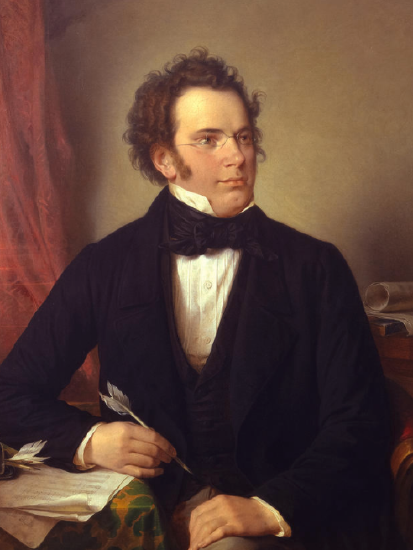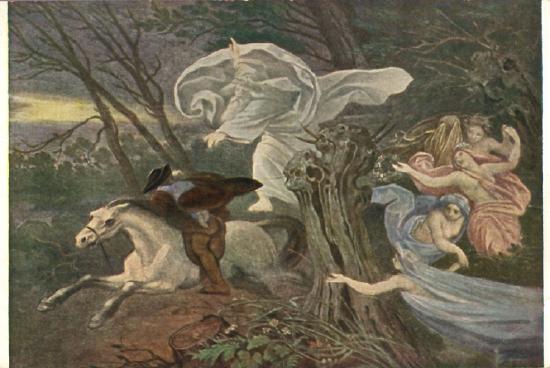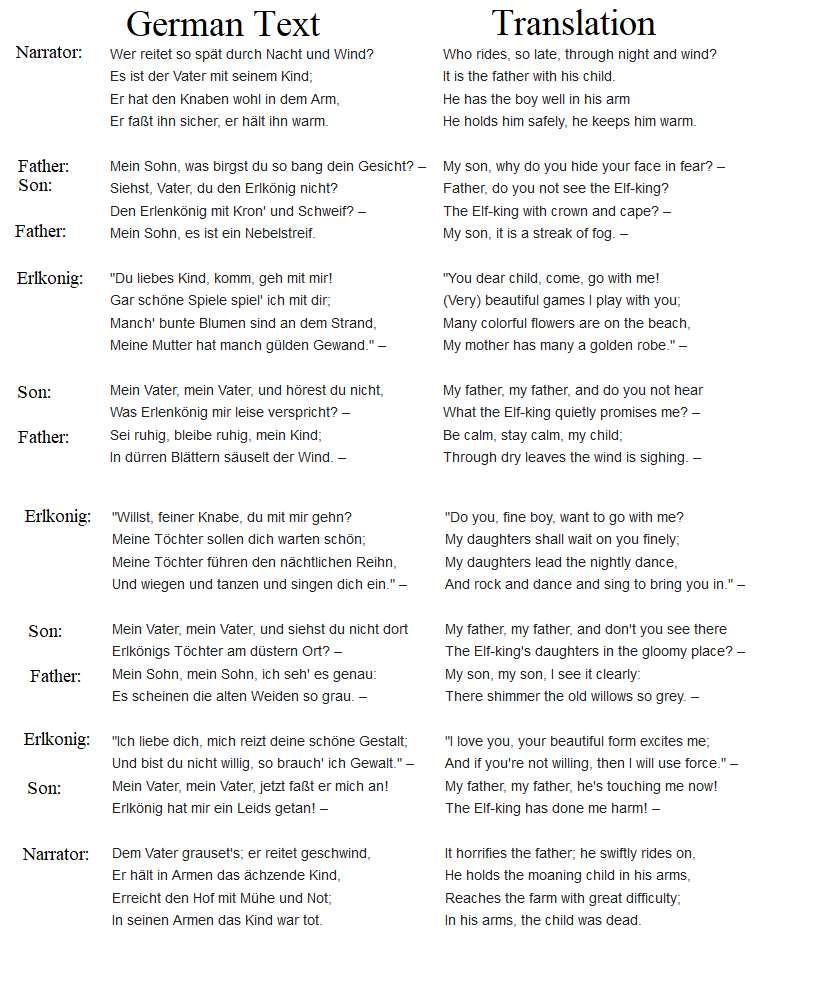11.5: Vocal Music in the 19th Century
- Page ID
- 169701
Schubert and the German Lied.
 Though Austrian composer Franz Schubert was a 19th century composer, he is considered by many music historians and scholars alike as a "bridge" between the Classical and the Romantic era. Born in 1797, he died in 1828—only 8 years into what many consider the beginning of the Romantic Era. He composed many pieces in the Classical tradition: instrumental sonatas, chamber music like string quartets, and symphonies. However, he is probably most well-known for his songs for voice and piano, of which he wrote over 600! These pieces called Lieder (plural of Lied, or a German song) were typically a few minutes long, similar to today's pop song. Some of his best known Lieder are based off of poems written by German poet Johann Wolfgang Goethe (known for his epic tragedy Faust).
Though Austrian composer Franz Schubert was a 19th century composer, he is considered by many music historians and scholars alike as a "bridge" between the Classical and the Romantic era. Born in 1797, he died in 1828—only 8 years into what many consider the beginning of the Romantic Era. He composed many pieces in the Classical tradition: instrumental sonatas, chamber music like string quartets, and symphonies. However, he is probably most well-known for his songs for voice and piano, of which he wrote over 600! These pieces called Lieder (plural of Lied, or a German song) were typically a few minutes long, similar to today's pop song. Some of his best known Lieder are based off of poems written by German poet Johann Wolfgang Goethe (known for his epic tragedy Faust).
As a Classical composer, Schubert wrote in many traditional forms and settings like the symphony, quartet, and sonata, as mentioned above. As a Romantic, however, Schubert was interested in exploring new ways to express human emotion. His melodies--both instrumental and vocal--are highly lyrical, and and explored new ways of modulating to keys that sound very distant to the ear. He was also interested in folklores and eerie subject matter, which we'll look at here.
Written when he was only 18 years old, Schubert set one of Goethe's poems titled "Der Erlkonig" to music. This poem is called a ballad, which is a poem that tells a narrative story. This famous story is rooted in old Danish folklore that tells of a demon who kills children in the woods by a single touch. Schubert took this poem and it set it to music for a single vocalist and pianist.
Portrait of Franz Schubert by Wilhelm August Rieder, Public Domain.
Der Erlkönig ("The Elfking")

Painting of the Erlkonigt by Moritz von Schwind. Public Domain.
This poem written by Goethe in 1782 depicts the "Elf King," or "King of the Fairies"—that stalks children in the woods. The painting above depicts such an incident: the child and his father are riding on horseback, the Erlkonig floats above, and his three fairie daughters are on the right. This eerie topic was the perfect subject matter for writers and musicians, alike. As you can see by the text, Goethe's poem has 4 different characters: the narrator, the child, his father, and the Erlkonig. Schubert's song only has a single vocalist, which means that the singer needs to do some voice acting to make it sound like he's 4 different characters! A successful performance of this piece depends on the singer's ability to portray different characters, without the aid of any type of setting or props.
Schubert helps out the singer by putting each character's voice in a different range. As one would suspect, the child has a higher range, and the narrator and father both have a lower range. Schubert puts the Erlkonig in a higher range as well, because as you can see from the lyrics, the Erlkonig is trying to lure the child to go with him. Read through this short poem before moving on:

Text-Music Relationship in Der Erlkönig
There are many instances of word painting and text-painting in this piece. At the onset, you'll hear the pianist hammering away the same note over and over, imitating a horse's gallop. You'll also hear the child lashing out "My Father, my father!" after each time that the Erlkonig speaks to him trying to lure him. You'll also notice that the Erlkonig sounds very innocent and sweet the first two times that he tries to lure the child, but during the third attempt, the harmonies underneath his words are very dissonant and, for lack of a better term, creepy sounding. Listen to this short song and follow along with the lyrics and translations below, and as you do, make sure sure you listen for these different ways that the music and text enhance one another. When you're finished, watch the video presentation that covers this piece for a more in-depth discussion on Schubert's compositional techniques.

